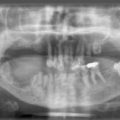Anal cancer
Implantation is rarely used as the sole treatment of anal cancer. Patients are initially treated with external beam radiotherapy to doses of 40–45 Gy over 4–5 weeks. Patients with tumours greater than 5 cm also should receive chemotherapy, either mitomycin-C and 5-fluorouracil or cisplatin-based combinations.
After 1–2 months to allow the tumour to regress and the reaction to settle, the patient undergoes an implant which is carried out under general anaesthesia. A horseshoe-shaped jig is placed against the anal skin and up to eight hollow needles are inserted 1 cm apart through the jig to cover the area of the tumour plus a safety margin. The needles extend beyond the tumour for two reasons. The first is to include occult disease and a margin of 1 cm is usual. The second is to compensate for gradual reduction of radiation dose at the end of the implant. Fifteen percent is added to length of the iridium at each end to ensure the clinical volume receives the full dose. A hollow syringe barrel is inserted into the anus to allow the escape of flatus or faeces. The jig is stitched against the patient’s skin and the needles are secured by a locking bar. The iridium is later inserted to give a dose of 15–25 Gy in 2–2½ days to the reference isodose line using the Paris system. This technique has yielded an impressive 93% three-year survival in a series of 48 patients with tumours under 5 cm. Six out of a total of 79 patients (7.6%) developed severe late complications.
Stay updated, free articles. Join our Telegram channel

Full access? Get Clinical Tree




